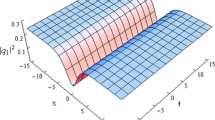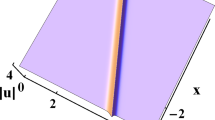Abstract
Dark three-dimensional spatiotemporal solitons or the “dark light bullets” in the self-defocusing nonlinear media with equal diffraction and dispersion lengths are demonstrated analytically. Our results show that the main characteristic of the dark light bullets can be described by the cylindrical Korteweg–de Vries (CKdV) equation. The dark wave packets are composed of the single-layer and multilayer toroidal rings. For the multilayer rings, there exist small inner rings enclosed in a large ring-shaped toroidal structure, when one chooses different orders of the soliton solutions of the CKdV equation. The radius of dark ring solitons increases with the propagation distance. Present results provide a feasible method for controlling the fundamental structure of these beams in the self-defocusing nonlinear media.



Similar content being viewed by others
References
Kivshar, Y.S., Agrawal, G.P.: Optical Solitons: From Fibers to Photonic Crystals. Academic, New York (2003)
Akhmediev, N., Ankiewicz, A.: Solitons: Nonlinear Pulses and Beams. Chapman & Hall, London (1997)
Zakharov, V.E., Shabat, A.B.: Exact theory of two-dimensional self-focusing and one dimensional self-modulation of waves in nonlinear media. Sov. Phys. JETP 34, 62–69 (1972)
Zhong, W.P., Belic, M., Huang, T.: Two-dimensional accessible solitons in PT-symmetric potentials. Nonlinear Dyn. 70, 2027–2034 (2012)
Chen, Y.X., Xu, F.Q., Jiang, B.Y.: Spatiotemporal soliton structures in (3+1)-dimensional PT-symmetric nonlinear couplers with gain and loss. Nonlinear Dyn. 82, 2051–2057 (2015)
Dai, C.Q., Wang, Y.Y.: Spatiotemporal localizations in (3+1)-dimensional PT-symmetric and strongly nonlocal nonlinear media. Nonlinear Dyn. 83, 2453–2459 (2016)
Bagnato, V.S., Frantzeskakis, D.J., Kevrekidis, P.G., Malomed, B.A., Mihalache, D.: Bose–Einstein condensation: twenty years after. Rom. Rep. Phys. 67, 5–50 (2015)
Taylor, J.R.: Optical Solitons: Theory and Experiment. Cambridge University Press, Cambridge (1992)
Hasegawa, A., Kodama, Y.: Solitons in Optical Communications. Oxford University Press, Oxford (1995)
Fischer, R., Neshev, D.N., Krolikowski, W., Kivshar, Y.S., Iturbe, C.D., Chavez, C.S., Meneghetti, M.R., Caetano, D.P., Hickman, J.M.: Oblique interaction of spatial dark-soliton stripes in nonlocal media. Opt. Lett. 31, 3010–3012 (2006)
Serkin, V.N., Hasegawa, A.: Novel soliton solutions of the nonlinear Schrödinger equation model. Phys. Rev. Lett. 85, 4502–4505 (2000)
Zhong, W.P., Xie, R.H., Belic, M., Petrovic, N., Chen, G.: Exact spatial soliton solutions of the 2D generalized nonlinear Schrodinger equation with distributed coefficients. Phys. Rev. A 78, 023821 (2008)
Kivshar, Y.S., Davies, B.L.: Dark optical solitons: physics and applications. Phys. Rep. 298, 81–197 (1998)
Malomed, B.A., Mihalache, D., Wise, F., Torner, L.: Spatiotemporal optical solitons. J. Opt. B: Quantum Semiclass. Opt. 7, R53–R72 (2005)
Mihalache, D.: Localized optical structures: an overview of recent theoretical and experimental developments. Proc. Rom. Acad. A 16, 62–69 (2015)
He, Y., Zhu, X., Mihalache, D.: Dynamics of spatial solitons in parity-time-symmetric optical lattices: a selection of recent theoretical results. Rom. J. Phys. 61, 595–613 (2016)
Malomed, B., Torner, L., Wise, F., Mihalache, D.: On multidimensional solitons and their legacy in contemporary atomic, molecular and optical physics. J. Phys. B: At. Mol. Opt. Phys. 49, 170502 (2016)
Yang, Z.P., Zhong, W.P., Mihalache, D.: Classification of families of exact localized solutions of potential-free Schrodinger equation in spherical coordinates. Rom. J. Phys. 61, 814–826 (2016)
Chen, S., Soto-Crespo, J.M., Baronio, F., Grelu, P., Mihalache, D.: Rogue-wave bullets in a composite (2+1)D nonlinear medium. Opt. Express 24, 15251–15260 (2016)
Silberberg, Y.: Collapse of optical pulses. Opt. Lett. 15, 1282–1284 (1990)
Zhong, W.P., Belic, M., Assanto, G., Malomed, B.A., Huang, T.: Light bullets in the spatiotemporal nonlinear Schrodinger equation with a variable negative diffraction coefficient. Phys. Rev. A 84, 043801 (2011)
Zhong, W.P., Belic, M., Assanto, G., Huang, T.: Three-dimensional spatiotemporal vector solitary waves. J. Phys. B: At. Mol. Opt. Phys. 44, 095403 (2011)
Huang, G., Makarov, V.A., Velarde, M.G.: Two-dimensional solitons in Bose–Einstein condensates with a disk-shaped trap. Phys. Rev. A 67, 023604 (2003)
Johnson, R.S.: Water waves and Korteweg-de Vries equations. J. Fluid Mech. 97, 701–709 (1980)
Zwillinger, D.: Handbook of Differential Equations, 3rd edn. Academic, Boston (1997)
Dai, C.Q., Wang, Y.: Infinite generation of soliton-like solutions for complex nonlinear evolution differential equations via the NLSE-based constructive method. Appl. Math. Comp. 236, 606 (2014)
Dai, C.Q., Wang, Y., Liu, J.: Spatiotemporal Hermite–Gaussian solitons of a (3+1)-dimensional partially nonlocal nonlinear Schrödinger equation. Nonlinear Dyn. 84, 1157 (2016)
Hietarinta, J.: Hirota’s bilinear method and soliton solutions. Physics AUC, vol. 15 (part I) 31-37 (2005)
Acknowledgments
This work was supported by the National Natural Science Foundation of China (Project No. 61275001) and by the Natural Science Foundation of Guangdong Province, China (No. 2014A030313799). Work at the Texas A&M University at Qatar was supported by the NPRP 6-021-1-005 project with the Qatar National Research Fund (a member of Qatar Foundation). MRB also acknowledges support from the Al Sraiya Holding Group.
Author information
Authors and Affiliations
Corresponding author
Appendix
Appendix
In this Appendix, we show how to obtain multiple soliton solutions of the KdV Eq. (7), represented in the Hirota’s bilinear form. The details can be find in any good introductory account of the Hirota bilinear method, such as [28]. To this end, we make use of the following logarithmic transformation: \(w\left( {\zeta , T} \right) \,{=}\,-2\frac{\partial ^{2}\ln f\left( {\zeta ,T} \right) }{\partial T^{2}}\). Substituting it into Eq. (7), we obtain a bilinear form of the KdV equation for f, as:

As usual, the Hirota bilinear operator is defined as
Special solutions for f can be obtained by expanding it perturbatively as \(f\,{=}\,1+\lambda f_1 +\lambda ^{2}f_2 +\lambda ^{3}f_3+\cdots \), where \(\lambda \) is supposed to be small. Plugging this ansatz into Eq. (9) and collecting terms pertaining to the same powers of \(\lambda \), we obtain a system of linear partial differential equations. From the expansion terms \(f_{1,} f_{2,} f_{3,{\ldots }}\) one forms the Nth-order solitary wave solutions of Eq. (7).
1.1 One-soliton solution
It is easily checked that if \(f_1 \,{=}\,\hbox {e}^{\Omega _1 }\) with \(\Omega _1\,{=}\,k_1 T-k_1^3 \zeta +\theta _{10} \), then \(f_{2} \,{=}\,f_3 \,{=}\,\cdots \,{=}\,0\). Letting \(\lambda \,{=}\,1\), we obtain the one-soliton solution of Eq. (7),
where \(k_1 \) and \(\theta _{10} \) are the KdV soliton amplitude and the initial phase shift, respectively.
1.2 Two-soliton solution
Equation (9) is a linear equation, for which the superposition principle holds, so we may add a number of exponential terms to \(f_2 \); let us suppose that \(f_1 \,{=}\,\text{ e }^{\Omega _1 }+\text{ e }^{\Omega _2 }, f_2 \,{=}\,\hbox {e}^{\Omega _1 +\Omega _2 +\Lambda _{{12}} }\), where \(\Omega _j \,{=}\,k_j T-k_j^3 \zeta +\theta _{j0}\ (j=1,2)\) and \(\text{ e }^{\Lambda _{12} }=\left( {\frac{k_1 -k_2 }{k_1 +k_2 }} \right) ^{2}\). Thus, letting \(\lambda \,{=}\,1\), we obtain the two-soliton solution of Eq. (7),
1.3 Three-soliton solution
When \(j\,{=}\,3\), the calculation of this case is a tedious but straightforward algebraic exercise. For \(f_j\ (j\,{=}\,1,2,3)\), we choose: \(f_1 \,{=}\,\text{ e }^{\Omega _1 }+\text{ e }^{\Omega _2 }+\text{ e }^{\Omega _3 },f_2 \,{=}\,\text{ e }^{\Omega _1 +\Omega _2 +\Lambda _{{12}} }+\text{ e }^{\Omega _1 +\Omega _3 +\Lambda _{{13}} }+\text{ e }^{\Omega _2 +\Omega _3 +\Lambda _{{23}} }, f_3 \,{=}\,\text{ e }^{\Omega _1 +\Omega _2 +\Omega _3 +\Lambda _{{12}} +\Lambda _{{13}} +\Lambda _{{23}} }\), where \(\Omega _j \,{=}\,k_j T-k_j^3 \zeta +\theta _{j0} \), in which each term describes a one-soliton. A long calculation then leads to the similar expression of the three-soliton solution of Eq. (7):
with \(\text{ e }^{\Lambda _{jl} }=\left( {\frac{k_j -k_l }{k_j +k_l }} \right) ^{2}\), where \(j<l\), \(j,l=1,2,3\).
1.4 The Nth-soliton solution
More generally, one can write the Nth-order solitary wave solution of Eq. (7) in the form:
where \(\exp \Lambda _{ij} \,{=}\,\frac{\left( {k_i -k_j } \right) ^{2}}{\left( {k_i +k_j } \right) ^{2}}\). The sum \(\sum _{\mu =0,1} \) involves all possible combinations of \(\mu _1 \,{=}\,0,1\); \(\mu _2 \,{=}\,0,1\)...; \(\mu _N \,{=}\,0,1\). It indicates that there are \(\hbox {2}^{N}\) terms. When all \(\mu _j \) are zero, the corresponding term is 1, while when \(\mu _{1} \,{=}\,\hbox {0}\) and other \(\mu _j \,{=}\,\hbox {1}\), the corresponding term is \(\exp \left( {\sum \nolimits _{j=2}^N {\left( {k_j T-k_j^3 \zeta +\theta _{j0} } \right) +\sum \nolimits _{2\le j<l}^N {\Lambda _{jl} } } } \right) \).
Rights and permissions
About this article
Cite this article
Zhong, WP., Belić, M.R. & Zhang, Y. Dark spatiotemporal optical solitary waves in self-defocusing nonlinear media. Nonlinear Dyn 87, 2171–2177 (2017). https://doi.org/10.1007/s11071-016-3180-8
Received:
Accepted:
Published:
Issue Date:
DOI: https://doi.org/10.1007/s11071-016-3180-8




